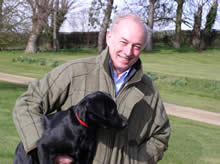| Printer Friendy Version |
TILL-SEEDING SHOWS SIGNIFICANT YIELD INCREASE IN HUNTS RAPE CROP
An increase in yield of up to 10 per cent has been achieved on over 1000 acres of oil seed rape using the Till-Seeding technique of one-pass subsoiling and seeding directly into stubble. 
Martin Eayrs of East Lodge Farm, Leighton Bromswold, Huntingdon, started growing rape 30 years ago and now has 1200 acres down to the crop. The remaining 2100 acres of the farm’s 3,300 acres of good, productive grade 2/3 land produces wheat.
His Till-seeding system has been developed over the past four years. “In the first season, we started with a 3.5 metre Cousins V-Form subsoiler with seven legs. In the second season we increased the width to 4.5 metres with nine legs,” said Mr Eayrs.
A second hand Seeder box was mounted on top of the subsoiler and worked well. “We experimented by putting the seed behind the leg and by broadcasting it right across in front of the packer roller at the back,” said Mr Eayrs.
“In a wet year it made no yield difference whether it was behind the leg or right across. But in a dry year it was definitely better with all the seed behind the legs.”
Checks on yields with a weighbridge confirmed that the switch to the new system was justified. “For the first two years we had better yields over conventional cultivation methods such as discing or power harrowing or both, and then drilling and rolling, by up to 10 per cent,” said Mr. Eayrs.
Last year he purchased a second 4.5 metre Cousins V-Form subsoiler on which was mounted an OPICO Variocast electronic seeder which he found was simple to fit, reliable - “and equipped with a good indicator to show what’s going on”.
This subsoiler was fitted with seven legs with a distance between the legs of 640mm, compared to 500mm on the first machine.
Mr Eayrs concluded that 500mm was definitely too close because it created excessive soil disturbance. “It breaks the soil up to such an extent that it is difficult to compact it afterwards,” he says, “so the optimum width for the legs I find is about 640mm.” This will be the basis, he says, for the two machines to operate in future.
Advantages of the system are that it is a one-man operation straight behind the combine and it improves timeliness - ”earlier crops are always better”, he says.
Also, the subsoiler leg pushes the straw out of the way allowing the seed to fall onto the cleared soil, leading to improved germination and yields.
“The fact that the seed falls down the fissure to various depths does not seem to create problems from varied times of germination,” says Me Eayrs.
“So in a wet year you get improved drainage allowing better plant root growth and healthier plants. In a dry year we find the seed finds the moisture down the fissure left by the leg and gets away quickly.
“This year we had very bad compaction from combines, trailers, balers and chasers and the use of this system has clearly been a huge benefit to get the seed to grow on compacted soil.”
The main disadvantage in Mr Eayrs’ opinion is the requirement for a higher horsepower tractor – 250hp plus – leading to higher fuel usage. Also, the system is slower than conventional techniques: “we’ll do 25-30 hectares per day per machine instead of 45/50 with a 6 or 8 metre conventional machine.”
It can be difficult to consolidate afterwards leading to possible slug problems, he adds, although he admits that surprisingly, so far there have been fewer slug problems than with conventional drilling methods.
“It can also be rough for top dressing and spraying unless you follow last year’s tramlines,” he adds.






